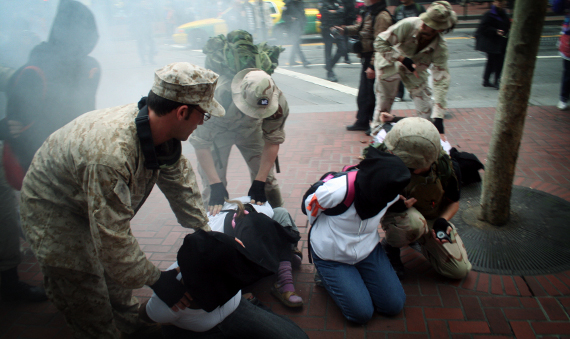By Nadine Bloch.
Last month, black hoods and orange jumpsuits stood out in stark contrast to the marbled pillars of the U.S. Supreme Court. It’s a jarring image — shackled prisoners framed by stately columns more accustomed to suited lawyers and robed judges. This guerrilla theater action on the 11th anniversary of the opening of the prison at Guantánamo Bay brought the pain, immorality and illegality of government detention and torture, intentionally hidden from view, into the public gaze.
Sometimes the first task of an activist is to make the invisible visible; if people can’t see an injustice, it is that much harder to change. Distance, ideology or even simple science often obscure very real problems. When was the last time you noticed lead in your house paint? Or PCBs in your drinking water, or dioxin in your air? It’s a similar challenge to stirring up public outrage about an offshore prison camp.
Particularly for those of us living in a privileged position on the map of empire, wars, torture and human rights abuses are often distant. But actions that bridge that distance can make a big difference. Witness Against Torture’s annual actions, along with other political work, has helped lead to a dramatic reduction of the number of inmates held at Guantánamo, although the prison has yet to be closed.
Washington, D.C., has seen its share of this kind of guerrilla theater over the years. In early 1971, Vietnam Veterans Against the War (VVAW) sponsored the Winter Soldier Investigation — a public venue for live, first-person testimony from soldiers about the true nature of the war and the policies shaping it. Meanwhile, VVAW vets in full combat gear staged mock search-and-destroy missions around D.C., rounding up Vietnamese actors, shooting them, dragging them by their hair, and generally instilling fear and panic among observers.
In the past decade, Iraq Vets Against the War (IVAW) has replicated these actions with a focus on Iraq and Afghanistan operations. IVAW vets conducted their own search-and-destroy theater, with “Operation First Casualty” teams in combat gear moving through Chicago during the presidential convention, as well as in New York, San Francisco and D.C. — detaining suspects all along the way, bringing tense desert situations to urban America. Operation First Casualty was so named, of course, because of the adage that “truth is the first casualty of war.”
Both guerrilla theater and storytelling through documentation are dramatic ways of inserting the horrors of a war and atrocities fought overseas into the daily life and consciousness of blissfully ignorant constituents — and potentially moving them to action.
Amnesty International is known around the world for bringing torture and illegal imprisonment out into the public realm as part of its efforts to end human rights abuses. Recently, Amnesty collaborated with artists in creating street installations featuring strip images of political prisoners on fences in a way that makes them visible to viewers moving past the fences. It places the prisoners outside of the bars, from a specific perspective, rather than behind them. Not only are the images compelling, but the way they are viewed reflects a complicated story of obscured truths and invites the viewer to get involved simply by stepping in to frame the image.
Another fascinating large-scale art project currently being produced to raise awareness of genocides and atrocities is the Bones Project. One million bones are being created by artists and activists for display on the National Mall this June. When the bones are laid out on the ground they will evoke a mass grave site; the display will be part art project, part participatory event, and part visceral, gut-wrenching social commentary. In this way the installation serves as a call to action, a way to educate and raise awareness, and a collaborative memorial for victims and survivors.
Perhaps the most longstanding and significant example of visualizing the invisible is the work of the Asociacion Madres de Plaza de Mayo, the Argentine women who publicly demonstrated, danced and sang for their disappeared children and husbands, in direct defiance of the military dictatorship during the “Dirty War” between 1976 and 1983, as well as after. They carried photographs or memorabilia, often scarfs representing diapers of their lost family members. Through their sustained actions at prisons and in the central plaza of Buenos Aires, they bore witness to their connection to the disappeared. There were many reasons for the power of their protest: the novelty of women taking the role of political protagonists in the male-dominated society, the sheer number of participants — which grew from 14 founders to thousands of supporters — and the ongoing, long-term physical presence of the women for more than 40 years.
Making a problem that is usually ignored seen — whether through guerrilla theater, storytelling, documentation, photographs or family members — can be strategically effective, especially when the powers that be are doing all they can to silence or hide the evidence. Using art and cultural expression to take on war and human rights abuses seems particularly fitting, as they represent an alternative mode of waging conflict for a more peaceful future.
The original article can be found on the Waging Nonviolence website here.










